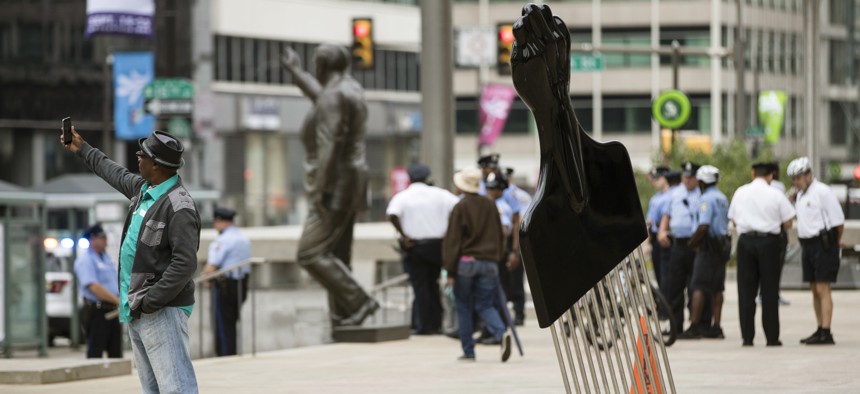What Happens to Community Bonds When a Neighborhood Gentrifies

A man takes a selfie with Hank Willis Thomas' All Power to All People sculpture. The sculpture, which has a black handle topped by a clenched fist, is part of an initiative to create public works about issues such as social justice and gentrification. AP Photo
A study of demographic changes in Philadelphia neighborhoods finds that an influx of more-affluent newcomers can erode community ties—or strengthen them.
A lot has changed over the last decade in Philadelphia’s Graduate Hospital neighborhood. Named after a long-closed medical facility, this residential area of modest brick rowhomes south of affluent Rittenhouse Square has been experiencing dramatic gentrification. Industrial landmarks like the Frankford Chocolate Factory and Marine Corps Depot are being demolished or converted into housing for newcomers. The working-class black population has shrunk and affordable housing units have disappeared; home prices are now $500,000. Last year, residents—old and new—grappled with the neighborhood’s new identity, hoping to rename the area after the African American icons who once lived there.
When a neighborhood gentrifies, existing residents may see positive effects—more affluent neighbors tend to bring safer streets and improved schools. But not everything changes for the better. Third-generation Graduate Hospital resident Rob Watson told the Philadelphia Inquirer’s Inga Saffron that he lamented the lack of black friends his daughter had in school. “To him, the conversation about renaming the neighborhood feels like a useless exercise because it can’t restore the web of relationships he once enjoyed,” Saffron wrote.
A new paper published online in the journal Urban Studies confirms Watson’s sentiment: When certain demographic changes take place in a neighborhood, community bonds can be weakened. It seems to depend in part on who, exactly, is moving in.
Gentrification is a complex—and contentious—process, and it can influence the dynamics of an area in myriad ways. Defined in the paper as “the growth in affluence,” some forms of gentrification boost neighborhood cohesion. Newcomers may select neighborhoods that have the potential for the kind of community they seek (think neighborhoods with a heavy LGBT presence, for example), so the sense of community strengthens as more people of a certain type settle in. Or perhaps the positive changes in the neighborhood—a more vibrant street life, lower crime, improved schools—bring about a sense of well-being and encourage civil engagement among all residents.
Researchers have not found that gentrification causes direct displacement, but it is known to usher in demographic turnover over time. So gentrification may stoke fear among existing residents of being displaced, or lead to a sense of alienation in their own homes. Certain types of racial and economic shifts that accompany gentrification may also cause tensions.
In the study, sociologists Joseph Gibbons at San Diego State University and Michael Barton and Timothy Reling at Louisiana State University examined results from a comprehensive health survey administered in Philadelphia in 2014 and 2015. It included measures for the strength of the community bonds between respondents, based on answers to questions about whether they trusted and would cooperate with neighbors and whether they felt a sense of belonging.
Using census data between 2000 and 2014, the researchers then categorized Philadelphia neighborhoods based on methodology from a previous study of gentrification in Philadelphia: “non-gentrifiable” were those with median household income above the city median; “gentrified” were poorer neighborhoods that saw increases in median home values and college-educated residents above the median change for the city (pockets in South and Central Philly, for example); and “non-gentrified” areas were the ones had a below-median household income but did not see change in this time, as in swaths of North and West Philly.
Their big-picture takeaway: The community connection was lower in gentrifying neighborhoods compared to those that did not, or could not, gentrify. This is important if you think of the link between community and, say, health outcomes or crime.
But the researchers also observed significant nuance when they broke gentrified neighborhoods down further by the types of demographic shifts observed in the process. In neighborhoods with “white gentrification,” where shares of white residents increased and black and Hispanic residents decreased, the researchers didn’t observe a significant difference to community. It’s possible that the bonding among newcomers offset what was lost among existing residents—but the researchers can’t say for sure. “It doesn’t mean that there’s nothing going on, but nothing that we’re capable of measuring,” Gibbons said.
In the case of “non-white gentrification,” where black and Hispanic shares went up and white shares did not, the researchers saw a positive boost to the area’s sense of community. “Mixed gentrification,” an increase in more-affluent white and non-white residents, drove the overall negative effect on community. This finding supports what some previous research on gentrification has concluded—that sometimes diversity may be superficial. “These neighborhoods may be in a demographic sense integrating, but socially they’re not integrating,” Gibbons said.
The study does not directly measure displacement and cannot make a causal connection between gentrification and community loss. But it does signal a need to scratch the surface of the phenomenon, and to understand some of the less-obvious cultural, psychological, and health effects of neighborhoods experiencing change. That might help tailor solutions towards those who get the short end of the stick in the process. One solution is to take a closer look at what’s happening in neighborhoods with non-white gentrification and see if those bonding connections can be replicated across racial lines. That, of course, requires grappling with deeper histories of race and class in American cities.
“Gentrification is happening whether we want it to or not—it’s a glacial force,” Gibbons said. “How can we harness it for good? For the many people who do remain in these neighborhoods even after they gentrify—how can we improve the well being of these people?”
Tanvi Misra is a staff writer for CityLab.
NEXT STORY: States Move to Ban Gay Conversion Therapy





